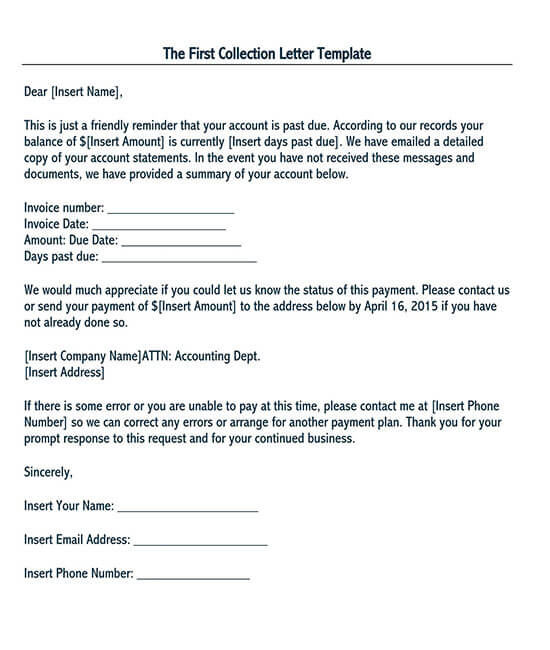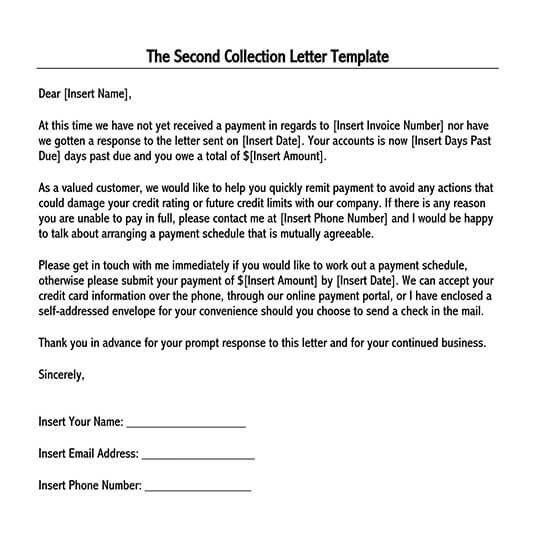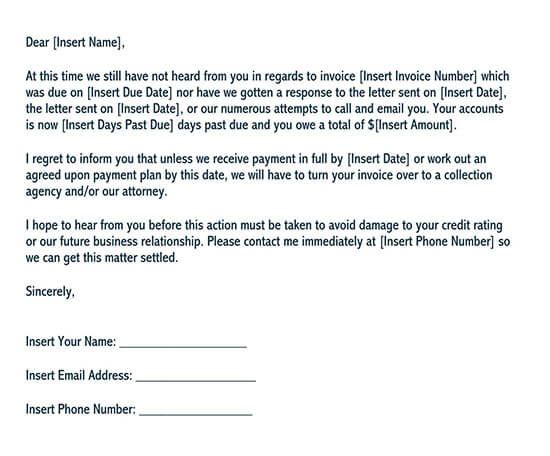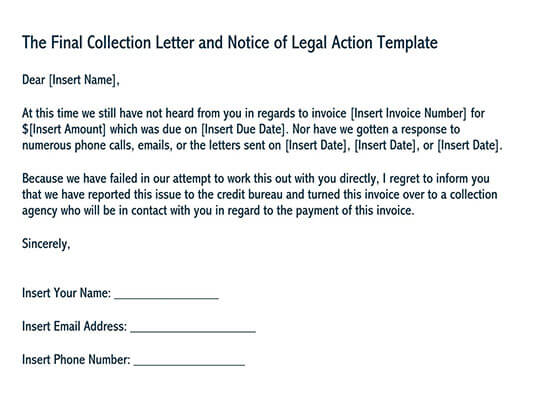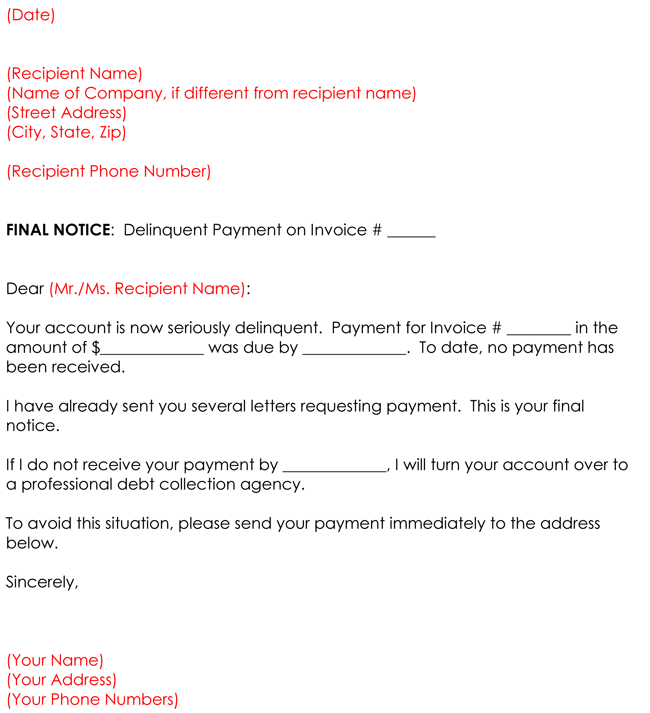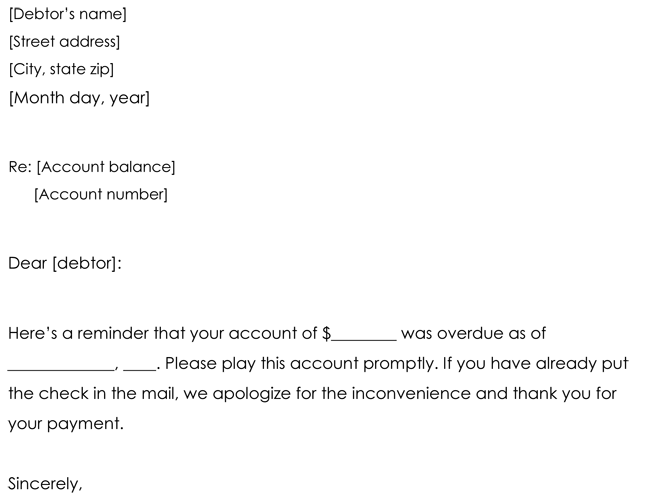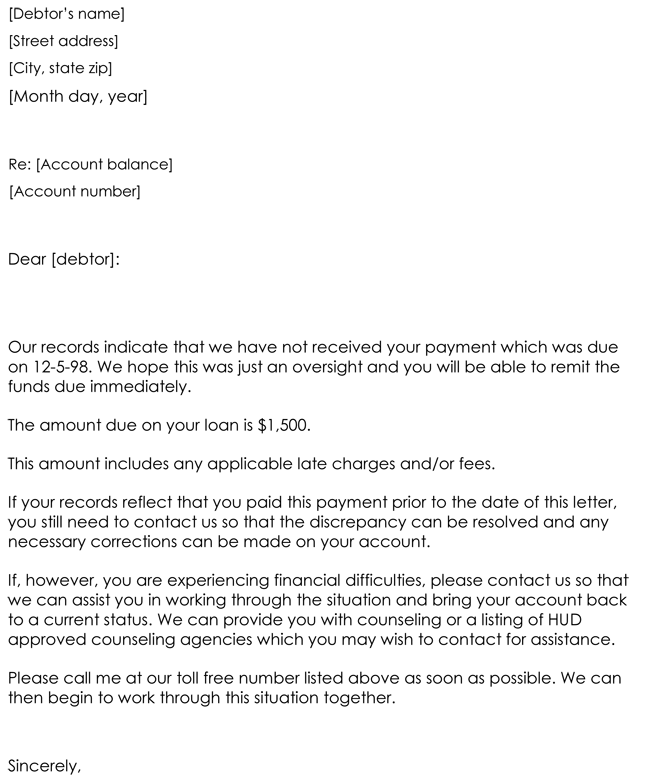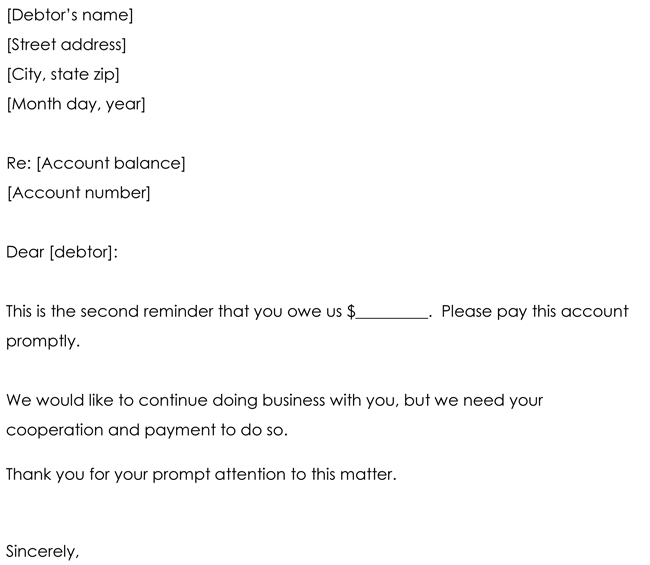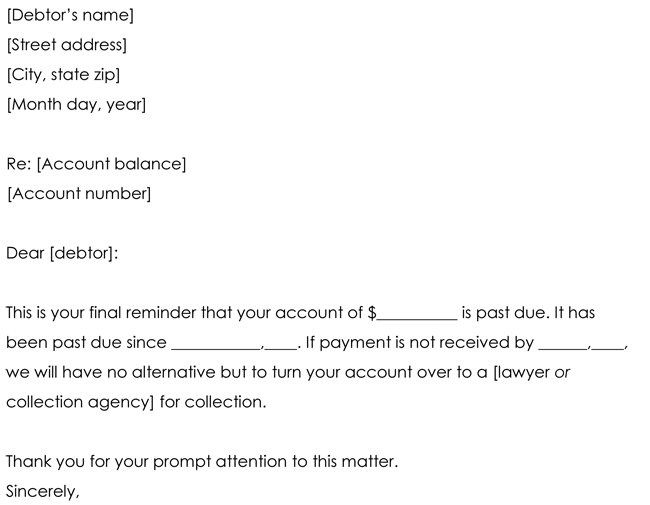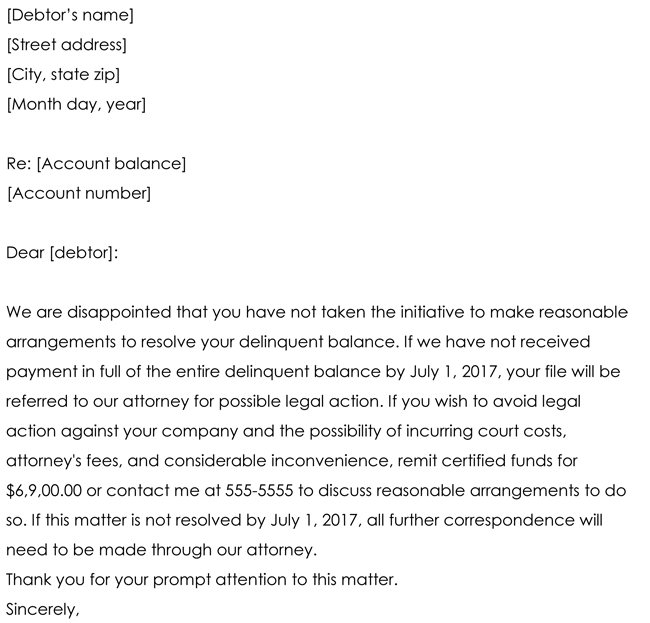When collecting payment of a debt in business, there is a step-by-step process that you use, which involves writing a collection letter.
A collection letter is used when a pending payment is due for goods and/or services. Businesses will use a total of 4 collection letters, each with a different format and tone before they move the debt over to a collection agency.
A collection letter is a way of reminding a customer that money is owed on a bill. The letters start off polite, but firm, and are a means of officially letting someone know their bill is overdue and needs to be paid.
Writing a Collection Letter
As mentioned earlier, there are four stages in writing collection letters, which we will go over shortly. For now, we are going to look at the information that you need to include when writing one. It’s important that you remain firm and professional and not use language that is complicated. Your letter should be short and get right to the point. Be sure that you type the letter on your company letterhead. You should also include a copy of the original invoice. Your letter should also contain:
- A payment date
- Acceptable payment methods
- Contact details of your business, which should include a full postal address, phone number, and email address.
- A pre-paid envelope to make it easy for the customer to make the payment
Most businesses want to not only get paid but to keep the business relationship with their customers. There are some things that you should and should not do when writing your collection letter.
Do
- Keep the tone professional
- Expect that the customer will make payment
- Make an attempt to contact the customer before you send the first collection letter, either via email or phone call
Don’t
- Harass your customers or use harsh language
- Contact the customer through texting or via social media
You can download one of our free templates or samples to get a better understanding of what a Collection Letter should look like through its various stages.
4 Stages of Collection Letters
As mentioned earlier, there are 4 stages in the collection letter process that you should follow.
First collection letter
When you have tried to reach your customer through other means (i.e., phone or email) but have not had any luck in making payment arrangements with your customer, you would send your first collection letter to them. This letter should be sent within 14 days from the date in the original invoice.
Keep in mind that this letter is based on the assumption that your customer forgot to make the payment. It is done in a friendly tone and can make a general assumption that their missed payment is down to financial or health issue, with an offer to help if they call. The letter should include:
- How many days past due the invoice is
- How much is due
- How many attempts have been made to reach the customer and by what means
- An account summary
- Instruction regarding what you require the customer to so next
- A payment due date (Try not to be vague with this, such as using “within 7 business days”)
- Your contact details
Sample of First Collection Letter
Dear Mrs. Jones,
We are sending you a friendly reminder that your account is now past due. Our records show that your current balance is $200.00, and the invoice is 7 days past its due date. We have sent you an email giving a copy of your statements for your account. However, if you have not received these details, we are providing you with an account summary.
Invoice number: 02234
Invoice Date: 08/21/20
Amount: $200.00
Due Date: 08/25/20
Days past due: 07
We would appreciate it if you could get in touch with us and let us know the status of payment, or to make a payment arrangement if you are having trouble paying the bill in full. Please contact us or send your payment of $200.00 to the address given below by September 8, 2020. Please disregard this letter if you have recently made your payment.
Garden Center of Queens
ATTN: Accounting Department
2425 Grove Street
Queens, New York
11237
If you are not able to pay this invoice or believe there has been an error, please give us a call at 212-456-0789 ext 15 so that we can make a payment plan that works for you or to correct any errors in billing. We thank you for your quick response to this letter and for your continued business.
Sincerely,
Katherine Gadsby
Garden Center of Queens
212-456-0789 ext. 15
Second collection letter
Also referred to as the “Inquiry” collection letter, the second letter that you send out is used to inquire as to the reason for not making payment. It should give some offer of help should the customer find it difficult to make the payment, offering to accept a payment plan or partial payment. You are still looking to keep a good relationship with the customer.
You should attempt to call or email the customer before you send a second letter out to be sure they received the first collection letter and see if they wish to make a payment plan to clear the bill. If you have not has any success in trying to contact the customer via phone or email, you would then send your inquiry collection letter.
You would use a similar format to the first collection letter, with the difference being that you point out that you have tried to reach them with your first letter. The second collection letter should include:
- Mention of any previous attempts to contact and take the collection of the due amount
- The invoices original due date
- How many days the bill is past due
- The amount owed and the invoice number
- An offer to assist the customer if they are unable to meet the terms of payment
- Instructions regarding what they need to do next
- Your contact details
You may also wish to add a reminder regarding how making late payments can have a negative impact on their credit and business ratings. Do this in a non-aggressive way.
Sample of Second Collection Letter
Dear Mrs. Jones,
We are writing again because we have not received your payment due for invoice #02234 nor have had any reply to our letter that was sent to you on September 1st. Your account is currently 14 days past due, and the total that you owe is $200.00.
As one of our valued customers, we would like to offer any help we can to make payment quickly in order to avoid taking actions that could have a negative impact on your credit score and any credit limits with our company in the future. If you are experiencing difficulties and cannot make the full payment, please call me on 212-456-0789 ext 15. I would be more than happy to speak with you and come up with a payment arrangement that works for us both.
If you would like to set up a payment plan, please get in touch as soon as possible. Otherwise, payment of $200.00 is expected to be made by September 15th, 2020. We can take payment over the phone using a credit card, via bank transfer, or through our online payment website. I have also enclosed a self-addressed stamped envelope to make it more convenient if you choose to pay by check.
We thank you in advance for your prompt reply to this letter and for your continued business.
Sincerely,
Katherine Gadsby
Garden Center of Queens
212-456-0789 ext 15
You can see the change in tone between both letters. The second letter mentions how a lack of payment can impact their credit standing in the business and their credit score. It is still polite but does put a bit more pressure on the customer to make a payment, as well as states your willingness to help the customer.
Third collection letter
If you have still not heard anything from the customer, and any other attempts to reach them by phone or email has failed, you would move on to the third collection letter, also known as the “Appeal” letter. This letter uses an approach and tone that is a bit more aggressive while still being fair. This letter will make mention of bringing a collection agency or lawyer onboard.
Again, be sure you make an attempt to reach the customer by email or phone before sending off the third letter. It’s advisable that you send the third letter via certified mail, which requires a signature and gives you proof that your letter was received. It’s important to have this should you be forced to take any legal action to collect payment for the debt in question. What you should include in this letter is:
- Mention all of your attempts to collect the debt, which should include any emails, phone calls, statements, and letters you have sent out
- The amount due and the invoice number
- The date of the original invoice
- How many days past due to the debt now is
- Instructions regarding what the customer needs to do next
- A warning regarding what steps will be taken if the instructions go ignored
- Your contact details along with one final request that they contact you.
Sample of Third Collection Letter
Dear Mrs. Jones,
We have still not had contact from you regarding invoice #02234, which was due on August 25th, 2020. We have also not had a reply to subsequent letters that were sent to you on September 1st, September 8th, and September 15th, nor to the numerous attempts, we have made to email and call you. Your account is now 21 days past due, and you owe a total of $200.00.
I regret to inform you that, unless we receive your payment in full by September 28th, 2020 or we hear from you to make a payment plan by that time, we will be forced to have to send your invoice to our attorney or a collection agency to obtain the debt owed.
We hope to hear from you before we have to take this action, which will damage your credit score and any future relationship with our business. Please contact us immediately at 212-456-0789 ext 15 so that we may settle this matter.
Sincerely,
Katherine Gadsby
Garden Center of Queens
212-456-0789 ext 15
You will notice that the tone of this letter loses the friendly aspect we saw in the first 2 letters, yet still remains professional. The mention of legal action is there but not in an aggressive way. It points out that, even though you intend to be paid the debt owed, you are still willing to work with the customer before those steps need to be taken.
Fourth and final collection letter
Should the third letter not get the response you wanted, you know you have done all that you are able at this point and need to move on to the fourth and final collection letter, also referred to as the “Ultimatum” letter. The tone and language of this letter should remain professional yet assertive. You should also send the fourth letter via certified mail as proof that it was received. If no attempt to make payment by the third letter has been made, it more than likely means the debtor is trying to avoid payment. The fourth letter should include the same details as the other letters.
Sample of Fourth Collection Letter
Mrs. Jones,
This is our FINAL NOTICE. We have made many attempts to contact you in regards to invoice #02234 for the amount of $200.00, and you have been offered ample time and assistance to pay this bill. Your account is now 28 days overdue, and we need to hear from you by September 22nd, or we will be passing the bill over to Arrow Collection Agency.
We expect payment in full by September 22nd, 2020, or we will have no choice to take legal action to get this dent paid.
Sincerely,
Katherine Gadsby
Garden Center of Queens
212-456-0789 ext 15
The final letter should have a sense of finality to it and tends to have a more terse tone to it. It should not be used until all other attempts have been exhausted.
When is the Right Time to Use a Collection Agency?
The use of a collection agency comes in when you have made numerous attempts to a customer to pay their bill and have gotten nowhere. Keep in mind that a collection agency tends to charge anywhere between 25% to 45% of the total debt amount, so you won’t be getting the full payment. If the debt is a small one and it doesn’t make sense to use a collection agency, you may wish to cut your losses and write the account off as a bad debt. This will allow you to claim the debt as a tax deduction.
Frequently Asked Questions
What are the four degrees of collection letters?
The four degrees of collection letters are the first, second, third, and final. They represent the order in which a debtor is contacted concerning money owed. The first degree requires that you notify the debtor in writing what they owe you. The second degree requires that they must also acknowledge in writing their failure to pay you at least two weeks before contacting you or your company. The third degree requires that when you contact them, it must be by these methods only. The final degree requires that you contact the debtor in writing once more. You must inform them of your intent to take legal action against them if they do not comply immediately.
What is the last stage of the collection letter?
The last stage of the collection letter is when you send a letter to the debtor informing them of your intent to take legal action. This stage aims to give notice that you intend to pursue legal action against them as they have failed to comply with the terms and conditions outlined in your previous correspondences.
In which collection letter does the seller give the buyer a legal threat?
The seller gives the buyer a legal threat in the final degree collection letter. A collection letter is considered the first stage of the collection process, meaning that if you do not hear from your debtor or have not received payment from them, you must contact them via phone. You must notify the debtor on at least two separate occasions, each one with a time-lapse of fourteen days between correspondence, before you can decide that legal action is needed.
